.
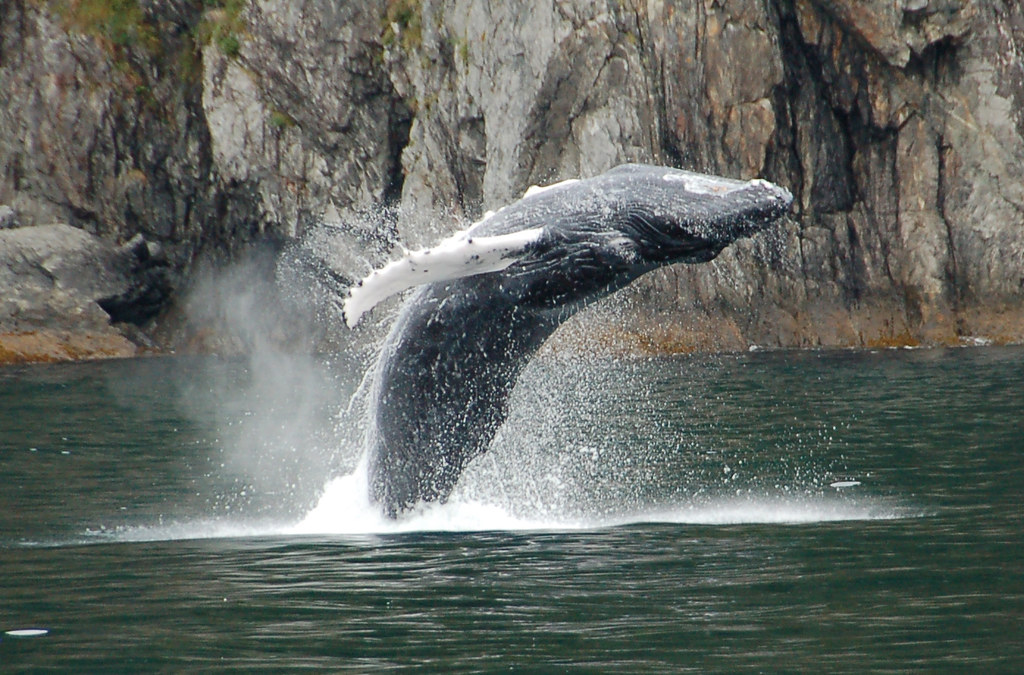
Humpback Whale breaching, Kenal Fjords National Park, Alaska: photo by jdegenhardt, 3 September 2009
This being the spring season, San Pedro, as well as all the other
open ports upon the coast, was filled with whales, that had come in to
make their annual visit upon soundings. For the first few days that we
were here and at Santa Barbara, we watched them with great
interest -- calling out “there she blows!” every time we saw the spout of
one breaking the surface of the water; but they soon became so common
that we took little notice of them. They often “broke” very near us; and
one thick, foggy night, during a dead calm, while I was standing
anchor-watch, one of them rose so near, that he struck our cable, and
made all surge again. He did not seem to like the encounter much
himself, for he sheered off, and spouted at a good distance. We once
came very near running one down in the gig, and should probably have
been knocked to pieces and blown sky-high. We had been on board the
little Spanish brig, and were returning, stretching out well at our
oars, the little boat going like a swallow; our backs were forward (as
is always the case in pulling), and the captain, who was steering, was
not looking ahead, when, all at once, we heard the spout of a whale
directly ahead. “Back water! back water, for your lives!” shouted the
captain; and we backed our blades in the water and brought the boat to
in a smother of foam. Turning our heads, we saw a great, rough,
hump-backed whale, slowly crossing our fore foot, within three or four
yards of the boat’s stem. Had we not backed water just as we did, we
should inevitably have gone smash upon him, striking him with our stem
just about amidships. He took no notice of us, but passed slowly on, and
dived a few yards beyond us, throwing his tail high in the air. He was
so near that we had a perfect view of him and as may be supposed, had no
desire to see him nearer. He was a disgusting creature; with a skin
rough, hairy, and of an iron-grey color. This kind differs much from the
sperm, in color and skin, and is said to be fiercer. We saw a few sperm
whales; but most of the whales that come upon the coast are fin-backs,
hump-backs, and right-whales, which are more difficult to take, and are
said not to give oil enough to pay for the trouble. For this reason
whale-ships do not come upon the coast after them. Our captain, together
with Captain Nye of the Loriotte, who had been in a whale-ship, thought
of making an attempt upon one of them with two boats’ crews, but as we
had only two harpoons and no proper lines, they gave it up.
Richard Henry Dana, Jr.: from Chapter XVIII in Two Years Before the Mast (1840)
Humpback Whale flukes. Taken off Surfer's Paradise, Queensland during the annual northerly migration from the Antarctic to the warmer waters of the Coral Sea: photo by Terry Howard, June 2005

Humpback Whale (Megaptera novaeangliae), two blowholes clearly visible, St. Mary's Ecological Reserve, Newfoundland and Labrador: photo by D. Gordon E. Robertson, 29 June 2010

Humpback Whale breaching, Stellwagen Bank National Marine Sanctuary, off Scituate, Massachsetts. Humpbacks frequently breach, throwing two-thirds or more of their bodies out of the water and splashing down on their backs: photo by Whit Welles, 20 August 2007

Humpback Whale breaching, Abrolhos Archipelago, Porto Seguro, Bahia, Brazil: photo by Amnemona (Marina C. Vinhal), 25 August 2007
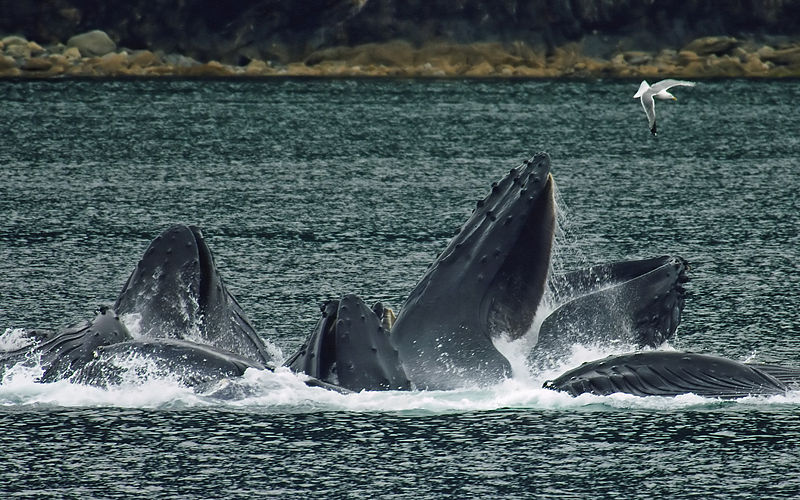
Humpback Whales in North Pass between Lincoln Island and Shelter Island in the Lynn Canal north of Juneau, Alaska. This is a group of 15 whales that were engaged in cooperative "bubble net" fishing: photo by Evadb, 18 August 2007; image by Jjron, 22 September 2007

A whale is captured by the Yushin Maru, a Japanese harpoon vessel. This image was taken by Australian customs agents in 2008, under a surveillance effort to collect evidence of indiscriminate harvesting, which is contrary to Japan's claim that they are collecting the whales for the purpose of scientific research. In 2010, Australia filed a lawsuit in the International Court of Justice hoping to halt Japanese whaling; this photograph will undoubtedly play a key role in that pending case: photo by Customs and Border Protection Service, Commonwealth of Australia, 6 February 2008

A harpooned Minke whale is captured by the Yushin Maru, a Japanese harpoon vessel: photo by Customs and Border Protection Service, Commonwealth of Australia, 6 February 2008
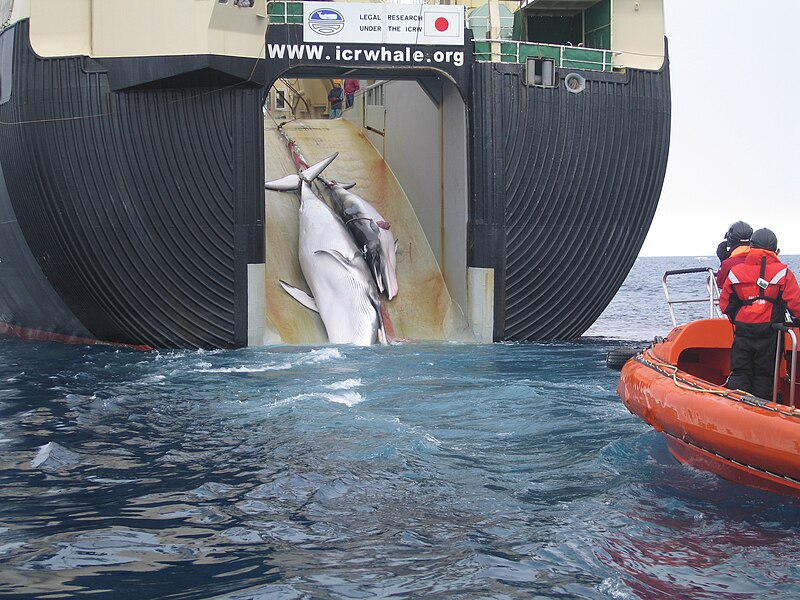
A Minke whale and her 1-year-old calf are dragged aboard the Nisshin Maru, a Japanese whaling vessel that is the world's only whaling factory ship. The wound that is visible on the calf's side was reportedly caused by an explosive-packed harpoon. The sign above the slipway reads, "Legal research under the ICRW". Australia released this photo to challenge that claim: photo by Customs and Border Protection Service, Commonwealth of Australia, 6 February 2008
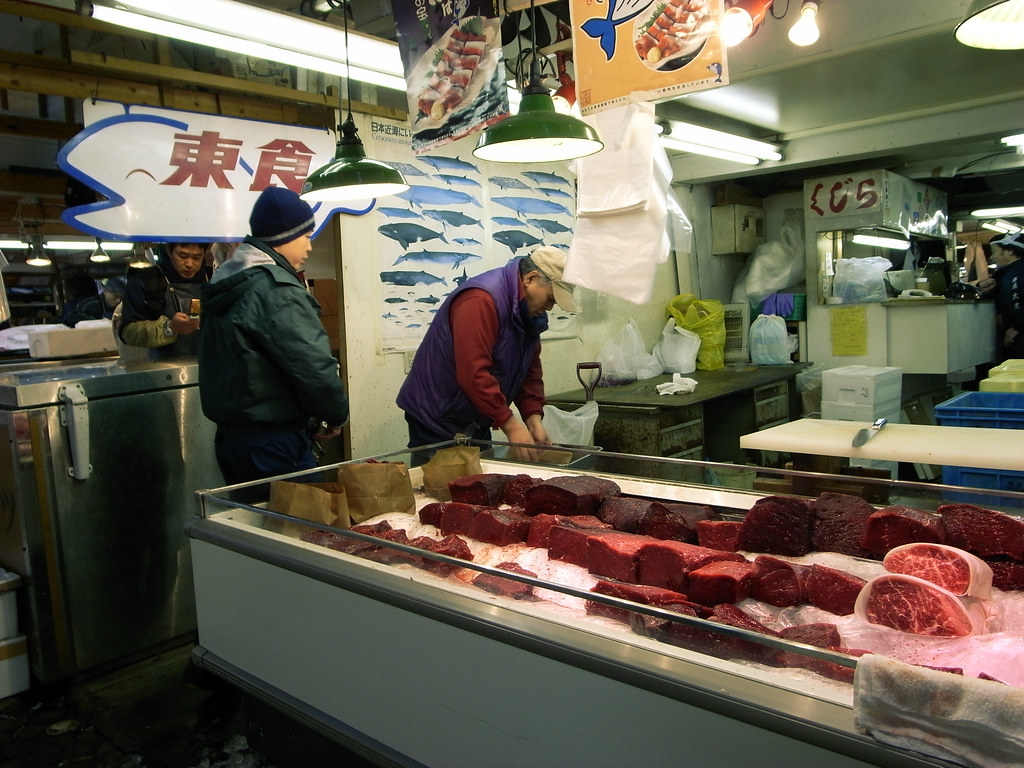
Save On Whale: whale meat on sale at the Tsukiji fish market, Tokyo: photo by spDuchamp, 4 February 2008
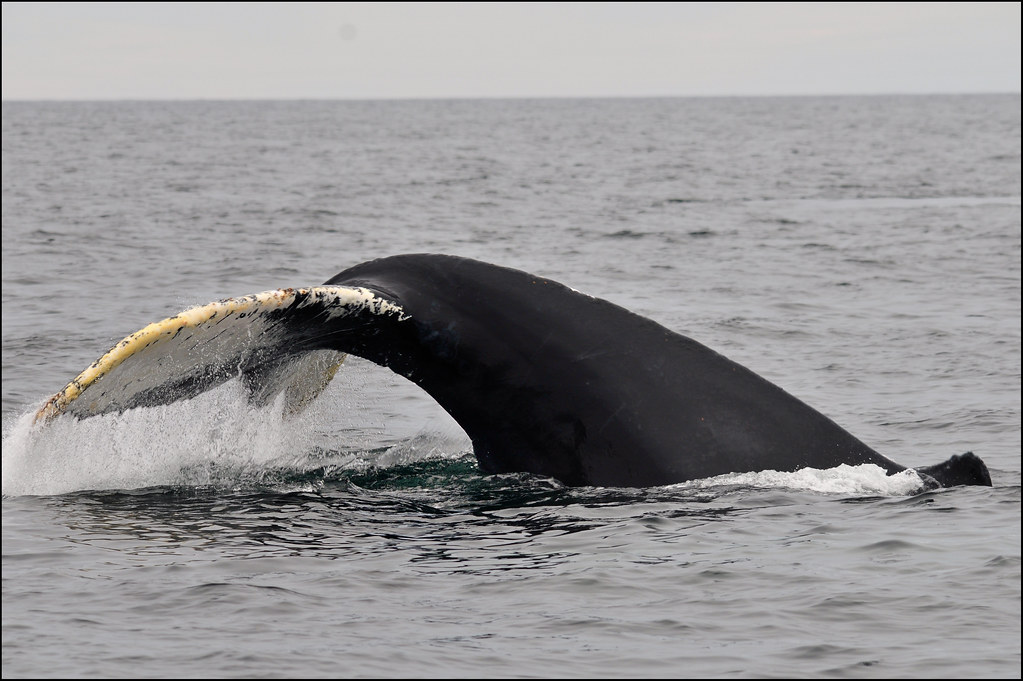
Humpback Whale submerging, off St. Anthony, Newfoundland: photo by Zircon_215, 3 August 2010

Humpback Whale tail, off St. Anthony, Newfoundland: photo by Zircon_215, 3 August 2010
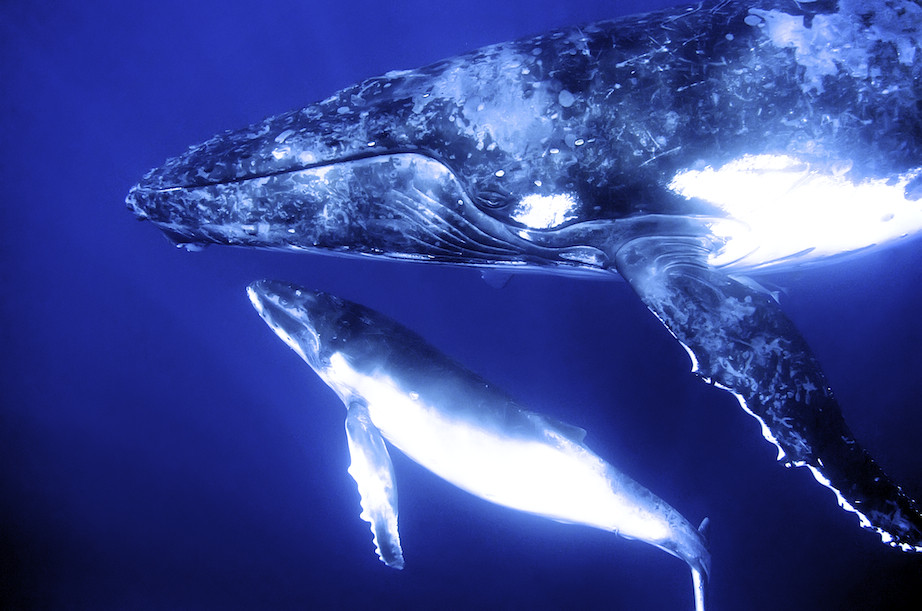
Humpback Whales, Tonga: photo by melissa fiene, 3 August 2010
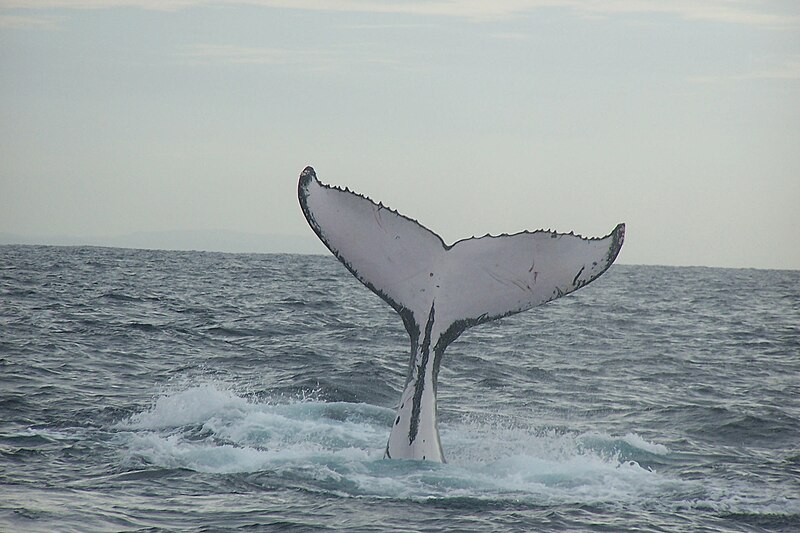
I've been cycling through this essay of photos for ten minutes . . . moving in a way I would not have expected . . .
ReplyDeleteThere's a terrible cultural discontinuity between the complex, highly-evolved social organization of the whales, and the brutal, unapologetic, technological harvesting of these creatures by this other allegedly complex, highly-evolved form of social organization.
ReplyDeleteTom,
ReplyDelete". . . and one thick, foggy night, during a dead calm, while I was standing anchor-watch, one of them rose so near, that he struck our cable, and made all surge again. . . ." Such a pure and innocent sense in Dana's account of this encounter with whales off California coast, perhaps the first (written) eyewitness evidence of such sightings. What beautiful creatures of the deep (and surface) and yes, such "cultural discontinuity" with what goes on aboard the Yushin Maru and other such vessels, not to mention the Tokyo Fish Market.
9.12
grey whiteness of fog against invisible
ridge, blue jay landing on apple branch
in foreground, sound of wave in channel
were in the air even before,
sense of human figure
two-dimensional plane, flat
picture surface, side
grey white of fog reflected in channel,
shadowed green pine on tip of sandspit
What Dana misses is the great stories etched into the whaleskin, rough as it is; nothing but beauty there.
ReplyDelete"He was a disgusting creature; with a skin rough, hairy, and of an iron-grey color."
ReplyDeleteSo much depends on the point of view.
A "terrible cultural discontinuity" sums it up all too well.
Steve, surely there is indeed a purity and innocence in Dana's account (teen years adventure reading for so many of us). No such innocence or purity possible however at the Tokyo Fish Market.
ReplyDeleteThe Food
ReplyDeleteShe’s wolfing down a can of beets
at the sink, standing there
with the can and a fork.
She swallows the slices down whole.
She is far away from here
because she is so angry.
The beets cool her rage
in her red throat—
tongues that can’t scream
in accentless English—
her widow’s peak
pointing the way down
to her white teeth.
The ocean histories carved into the whaleskin must be epic.
ReplyDeleteThe practice of "bubble net" fishing, in which groups of whales swim in narrowing circles, meanwhile blowing bubbles that herd the fish inward and upward -- extremely intelligent group behaviour.
Talking of skins... the purpose of the expedition in which Dana had enlisted was to gather skins, and much of his work on the California shore came in curing and packing hides.
ReplyDeleteRainbow-held time
ReplyDeletebig things small
small things big
hairy
like the whales
of Shangri-La
spotted
misty
plumes whole bodies
suspended
air
curved.
They are
grand
gleaming towers
of Lost Horizon
now beggar refugees
in squat
lost
squat horizon.
there was a girl who believed
ReplyDeletethat poetry could save the world
and I believed in what she said
and messages were sent on clouds
and ravens' wings.
we even co-opted random
radio waves.
Manahatta cerulean blue,
I believed in you and though,
faded I follow your
course via the weather channel's
regional radar, heavy snows
in your area, drought in mine.
It turned out this way
and today it's for whales.
From you I'm hard to
fool.
the surround crowd sports
sayings as in
SAVE THE WHALES vs the cynical
NUKE THE BABY WHALES
and that's why, though poetry is
not quite cut out to save the
world, if the language can mean
what it says
the poets would atleast have
done their job.
Charlie,
ReplyDeleteWe all remember the days of saving the world, the whales, the humans, everything living, the sacredness of the land and its creatures. And you my friend actually went out and set your sails on doing that, and have achieved many great things. So while it's obvious that the silly and often uninformed idealism of the young (well, some of the young) looks pretty futile in light of the overwhelming powers now aligned against life, it's still some consolation that not everybody is ready as yet to bow down before the God of the Android Smartphone. Maybe youthful idealism is a kind of vitamin a culture needs if it's to have any chance to survive.